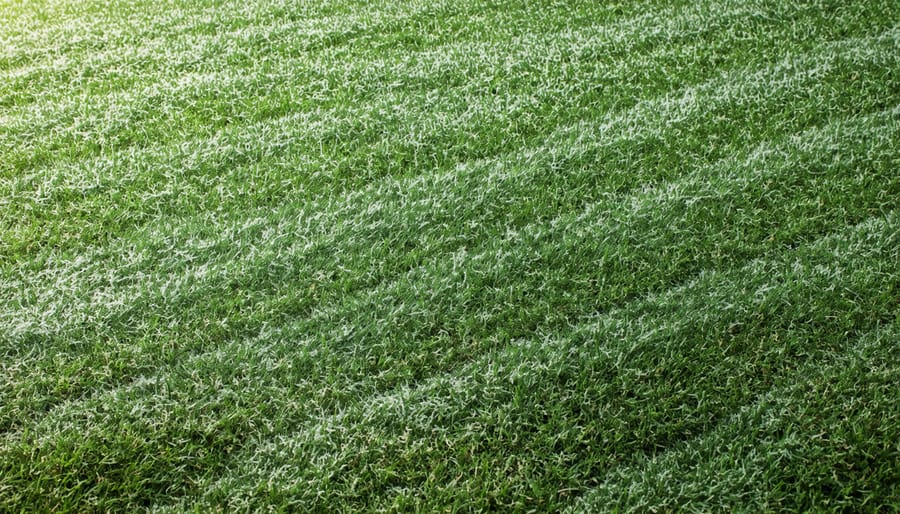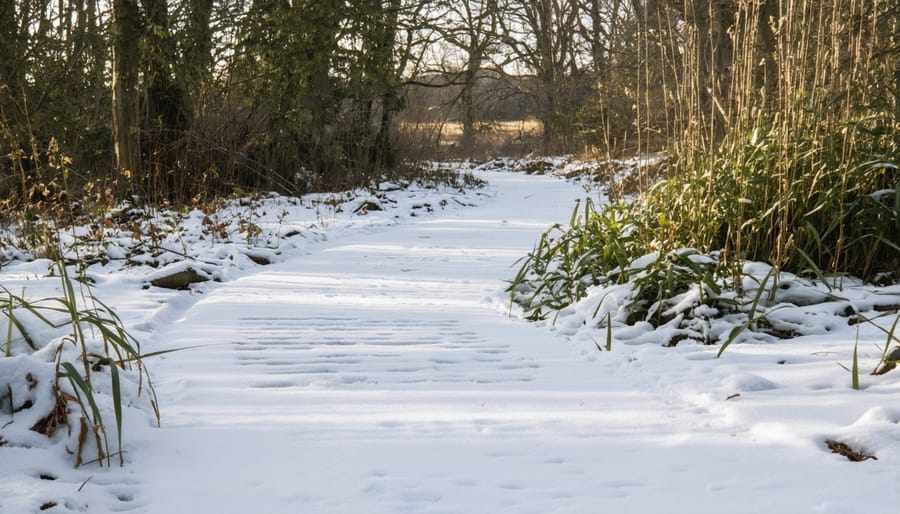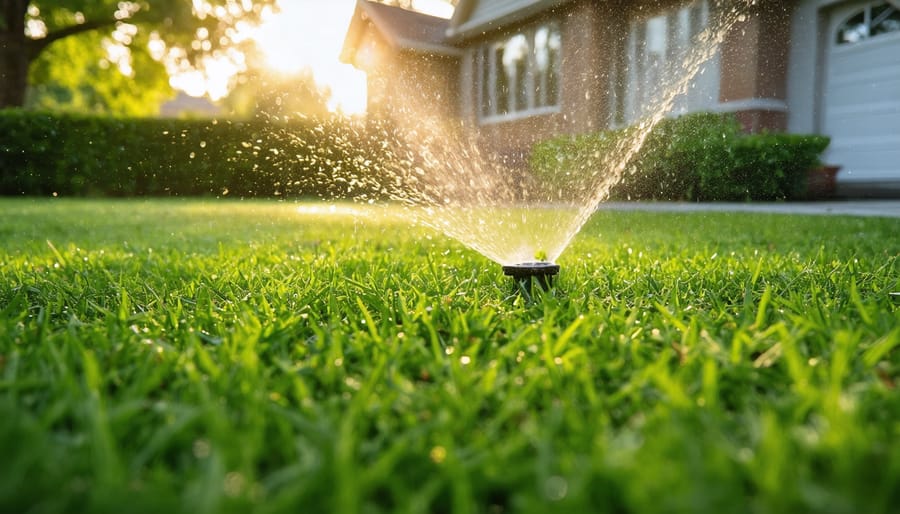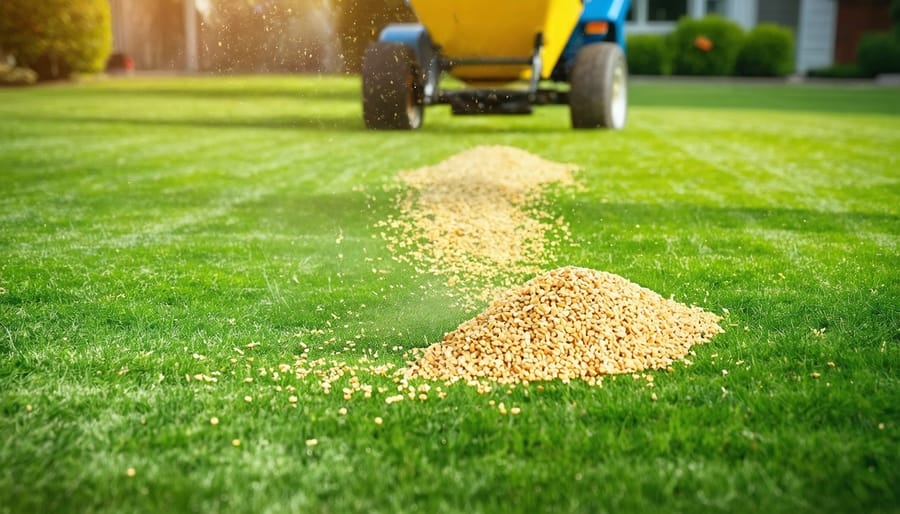Protect your lawn’s dormant root system by mowing one final time at 2-3 inches before the first frost, removing excess leaf debris and thatch that can suffocate grass during winter months. Apply a slow-release winter fertilizer rich in phosphorus and potassium to strengthen roots and help maintain healthy grass year-round. Test soil pH levels now and add necessary amendments, allowing them to integrate throughout the cold season for optimal spring growth. Aerate compacted areas before ground freezes, creating pathways for water, nutrients, and oxygen to reach root systems during winter dormancy.
Winter lawn preparation isn’t just about protecting your grass through the cold months – it’s about laying the groundwork for a lush, vibrant spring lawn. Strategic care now prevents common spring issues like dead patches, fungal diseases, and weak root systems that plague unprepared lawns. By investing time in these essential winter preparations, you’re setting your lawn up for successful spring growth while reducing the need for intensive rehabilitation once temperatures warm.
Final Fall Duties Before Winter Sets In
The Last Mow Matters
That final mow before winter sets in is more crucial than you might think. The key is finding the sweet spot – you want your grass short enough to prevent matting under snow and ice, but not so short that you expose the crown to harsh winter conditions.
For most cool-season grasses, aim for a height between 2 to 2.5 inches. This length provides enough protection for the grass crowns while reducing the risk of snow mold, a common winter lawn disease. Time this last cut when your grass has mostly stopped growing, typically when daytime temperatures consistently fall below 50°F (10°C).
Watch the weather forecast carefully before making that final cut. Mow when the grass is dry to ensure a clean cut, and avoid mowing if there’s a frost warning. Remember to keep your mower blades sharp – a clean cut helps prevent damage and disease during the dormant period.
As you complete this final trim, be sure to bag the clippings rather than leaving them on the lawn. This prevents any potential smothering of the grass during winter months.

Clear the Canvas
Before diving into your spring fertilization schedule, it’s essential to give your lawn a clean slate. Think of your yard as a canvas that needs clearing before creating your masterpiece. Start by thoroughly removing fallen leaves, which can smother grass and create the perfect environment for snow mold to thrive. Don’t forget those often-overlooked corners where leaves tend to gather!
Use a lightweight rake to gently lift matted grass and remove any lingering debris. This process, known as winter cleanup, helps prevent fungal diseases and allows your grass to breathe. Pay special attention to areas where snow has compacted the grass – these spots are particularly vulnerable to snow mold development.
If you spot any thatch (that layer of dead grass between soil and living grass), now’s the time to address it. A light dethatching can work wonders for your lawn’s health. Remember, the goal isn’t to strip your lawn bare but to remove potential barriers to spring growth. Consider composting the collected organic matter – it’s a sustainable way to turn winter waste into spring nutrition for your garden.
Soil Health: Your Winter Priority
Winter pH Testing
Winter might seem like an odd time to test your soil’s pH, but it’s actually an ideal opportunity to assess and plan for spring amendments. While your lawn is dormant, you can get an accurate baseline reading of your soil’s chemistry without the interference of active growth cycles or recent fertilizer applications.
Testing during winter gives you ample time to make informed decisions about spring treatments. Most grass varieties thrive in soil with a pH between 6.0 and 7.0, and knowing where your soil stands allows you to plan necessary adjustments well in advance. You can purchase an at-home testing kit from your local garden center or collect soil samples to send to your county extension office for a more detailed analysis.
To properly test your soil, collect samples from several areas of your lawn, about 4-6 inches deep. Mix these samples thoroughly in a clean bucket to get a representative sample of your entire lawn. If you’re using a home testing kit, follow the manufacturer’s instructions carefully, and make sure to test in multiple spots for accuracy.
Should your test reveal that pH adjustments are needed, winter provides the perfect timeline for slow-acting amendments like lime or sulfur to gradually work their way into the soil before spring growth begins. Remember to keep records of your test results to track changes over time and establish a pattern for future maintenance.

Strategic Winter Fertilization
Winter fertilization is a crucial step in preparing your lawn for spring success, but timing and product selection are everything. The key is to apply a winter-specific fertilizer that’s high in potassium and phosphorus, but lower in nitrogen. This combination helps strengthen root systems and build cold tolerance without promoting excessive top growth that could be damaged by frost.
For optimal nutrient management, apply your winter fertilizer when the grass has stopped growing but before the ground freezes solid. This typically falls between late October and early December, depending on your climate zone. Look for fertilizers labeled as “winterizer” or “winter preparation” with an NPK ratio around 3-1-2 or 5-1-4.
The application process is straightforward: ensure your lawn is dry and use a broadcast spreader for even coverage. Apply at a rate of about one pound of nitrogen per 1,000 square feet of lawn. Water the fertilizer in lightly if rain isn’t expected within 24 hours.
For an eco-friendly approach, consider using organic winter fertilizers like bone meal or seaweed-based products. These release nutrients slowly and help build soil health naturally. Whatever product you choose, always read the label carefully and avoid over-application, which can lead to nutrient runoff and environmental issues.
Remember, winter fertilization isn’t about promoting growth – it’s about strengthening your lawn’s foundation for spring revival.
Protect Your Lawn’s Winter Sleep
Traffic Control
Winter can be particularly harsh on your lawn, especially when frozen grass becomes brittle and susceptible to damage. During these cold months, it’s crucial to minimize foot traffic across your lawn to prevent long-lasting damage that could affect your spring growth.
Create designated pathways using stepping stones or mulch to direct foot traffic away from your grass. If you must walk on the lawn, try to wait until the afternoon when the grass has thawed slightly. Frozen grass blades can actually break when stepped on, leaving permanent damage that won’t heal until new growth begins in spring.
Consider placing temporary signs or markers to remind family members and visitors to stick to pathways. This is especially important after a frost or snow, when the temptation to walk across the lawn might be higher. If you have children or pets, try to establish a winter play area away from the main lawn, perhaps on a patio or designated space.
For areas that absolutely must handle some traffic, consider laying down wooden boards temporarily to distribute weight more evenly and protect the grass beneath. Remember, any damage done to frozen grass will be visible in your spring lawn, so a little precaution during winter goes a long way.

Snow Management
When it comes to snow management, how you handle that white blanket on your lawn can make a significant difference in spring growth. While it might be tempting to pile snow wherever convenient, strategic removal helps protect your grass and promote healthy spring recovery.
Start by avoiding the creation of large snow piles on grass areas. Heavy snow mounds can lead to snow mold, compress grass blades, and create dead spots in your lawn. Instead, distribute snow evenly across non-grass areas like driveways or designated garden spaces when possible.
If you must clear snow from your lawn, use a plastic shovel rather than metal ones, as these are gentler on grass blades and reduce the risk of accidentally scalping your turf. When using a snow blower, adjust the height to avoid catching grass crowns, and try to maintain a consistent direction of snow discharge to prevent uneven accumulation.
Be particularly mindful of snow that’s been treated with de-icing products. These chemicals can harm grass and soil health, so avoid pushing treated snow from walkways onto your lawn. Instead, direct this snow to less sensitive areas.
For areas where snow naturally accumulates, consider placing markers along walkways and garden boundaries before the first snowfall. This helps prevent accidental lawn damage during snow removal and protects decorative features or delicate plants hidden beneath the snow.
Winter Weed Watch
Winter weeds can be sneaky invaders, taking advantage of your dormant lawn to establish their foothold. Common winter troublemakers include henbit, chickweed, and annual bluegrass, which thrive in cooler temperatures. These opportunistic plants are easier to spot against the dormant brown grass, making winter an ideal time for identification and control.
To keep these unwanted guests in check, start by regularly inspecting your lawn for new weed growth. Young weeds are much easier to manage than established ones. For small infestations, hand-pulling is an eco-friendly solution – the moist winter soil makes this task surprisingly manageable. Be sure to remove the entire root system to prevent regrowth.
For larger problem areas, consider applying a pre-emergent herbicide in late fall to prevent winter weed seeds from germinating. If you’ve missed this window, post-emergent treatments can still be effective when applied on warmer winter days (above 50°F). Always opt for selective herbicides that target specific weeds without harming your dormant turf grass.
Remember, a thick, healthy lawn is your best defense against winter weeds. Maintaining proper mowing height and good soil health during the growing season will help create a natural barrier against these cold-season invaders.
Early Spring Planning
Equipment Ready
Winter is the perfect time to give your lawn care equipment the attention it deserves. Start by thoroughly cleaning all your tools, removing any dirt, grass clippings, or rust that accumulated during the growing season. Use a wire brush for stubborn debris and apply a light coat of oil to metal surfaces to prevent rust.
For power equipment like mowers and trimmers, drain the fuel tank or add a fuel stabilizer to prevent carburetor issues. Change the oil, replace spark plugs, and sharpen blades while you have the downtime. Clean or replace air filters to ensure optimal performance when spring arrives.
Don’t forget about your manual tools. Sand wooden handles to remove splinters and apply linseed oil to prevent cracking. Sharpen the edges of shovels, spades, and pruning shears. Store all tools in a dry place, preferably hanging on a wall or organized in a tool rack to prevent damage and rust.
This is also an excellent time to inventory your supplies. Check the condition of your spreader, assess whether you need new sprayer nozzles, and make a list of replacement parts you’ll need. Consider upgrading any worn-out equipment during winter sales when prices are often lower.
By maintaining your equipment during winter, you’ll be ready to tackle spring lawn care tasks without delays or equipment failures.
Spring Schedule Setup
Getting ahead of your spring lawn care requires thoughtful planning during the winter months. Create a comprehensive schedule now to ensure you’re ready to implement effective spring lawn care strategies when the weather warms up.
Start by marking your calendar for early March soil testing, which helps determine what amendments your lawn needs. Schedule core aeration for when the soil is moist but not waterlogged, typically in early spring. Plan your first fertilizer application for when grass begins actively growing, usually when soil temperatures consistently reach 55°F.
Set reminders for weekly lawn inspections starting in late February to monitor for snow mold or winter damage. Schedule your first mowing when grass reaches about 3 inches in height, typically in early to mid-March depending on your climate zone. Plan to overseed any bare patches once soil temperatures remain above 50°F.
Create a maintenance checklist that includes:
– Early March: Clean up winter debris
– Mid-March: Sharpen mower blades
– Late March: First fertilizer application
– Early April: Begin regular mowing schedule
– Mid-April: Start weed prevention
Remember to adjust these dates based on your local climate and weather patterns. Keep your schedule flexible, as spring weather can be unpredictable. Having this timeline ready will help you transition smoothly from winter dormancy to active growth.
As we’ve explored, preparing your lawn for winter is a crucial investment in your spring garden’s success. By taking action now, you’re setting the stage for a lush, healthy lawn when warmer weather returns. Remember to complete your final mowing at the right height, remove fallen leaves and debris, and apply a winter fertilizer before the ground freezes. Don’t forget about those essential soil tests – they’re your roadmap to understanding exactly what your lawn needs to thrive.
Aerating and overseeding in late fall can make a significant difference in how your lawn bounces back in spring. Taking care of these tasks before winter sets in gives grass roots time to establish themselves and helps prevent soil compaction. Additionally, maintaining proper drainage and addressing any existing lawn problems will prevent them from worsening during the harsh winter months.
The key to successful winter lawn prep is timing – don’t wait until the first frost catches you off guard. Start your preparations while temperatures are still mild and the ground is workable. By investing time and effort now, you’ll save yourself considerable work and expense when spring arrives.
Remember, a well-prepared winter lawn is your best defense against cold weather damage and the surest path to a vibrant spring garden. Your future self will thank you for the effort you put in today. So grab your tools and get started – your lawn’s spring success story begins this winter.




